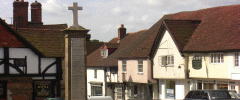St Ann's Hill and Midhurst Castle
What is highly likely is that Midhurst Castle, like those in Chichester, Bramber and Pulborough, was built to safeguard the Normans' stronghold in Sussex immediately after the Norman Conquest of 1066.
Like Pulborough Castle, which was built at the same time near the confluence of the River Rother and the Arun, Midhurst Castle was built on a high place overlooking the river. The River Rother was a key strategic transport route for both trade and military items as the roads in the Weald were so poor at that time. St Ann’s Hill was an obvious location for such an important building.
At first the Castle consisted of wood and earthwork defences, with an inner bailey on top of St Ann’s Hill and a further bailey on the westward slopes of the hill. Later stone walls and buildings were incorporated to beef up the castle’s defences.
The Castle became the main catalyst in the growth of Midhurst into a sizeable town. The oldest parts of Midhurst are the attractive area around Sheep Lane, Church Hill and Edinburgh Square where trade started to take place to support the life of the Castle. In time this developed into the more formal market that underpinned much of Midhurst’s wealth in the Middle Ages.
Only the foundation stones of the Castle remain today, of course, but it doesn’t take much imagination to take yourself back to the eleventh century when it was a fully functioning part of the Norman military machinery.
OTHER STUFF
About us
Contact us
Privacy policy
copyright
© Midhurst.org 2008-12.
Monday March 31

